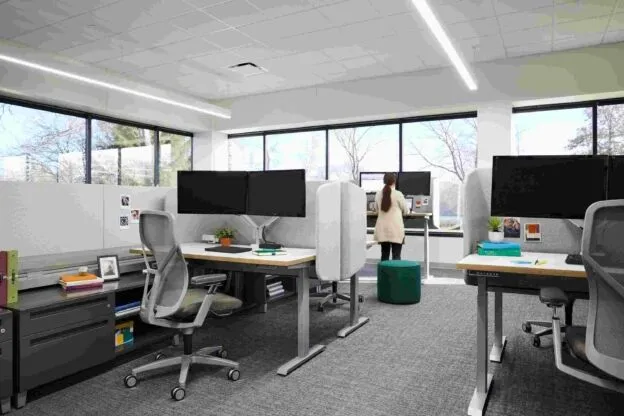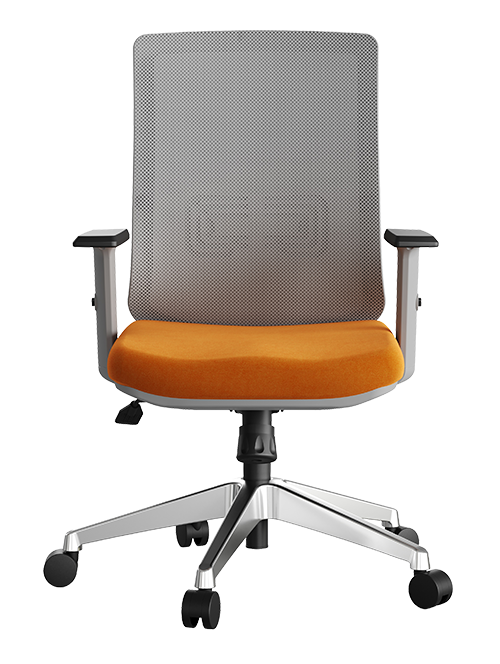Is Your Space Fit to Stand

The demand for adjustable worksurfaces has increased, but once installed, some employees find that using them is not as easy as expected.
We would like to address these conflicting forces (the desire for adjustability vs. the difficulty in effective use) and offer potential solutions.

Employee perk: Adjustable height workstations are occasionally offered to employees as an additional benefit, especially when other, less favorable changes are being implemented, such as space restrictions or relocations.
Decreasing costs: Height adjustability is becoming more attainable for budget-conscience clients. More affordable options are available, and adjustability is being considered in new products all the time.
Wellness programs: Employees and employers understand the importance of occupational wellbeing, and workplace wellness programs and standards are becoming increasingly prevalent. Adjustable worksurfaces are often considered in these efforts to introduce movement throughout the workday.
Industry trend: The American Society of Interior Designers (ASID) included sit-to-stand as a top trend in the interior design industry for addressing health and well-being.
Aid collaboration: Workers report that standing postures allow for more efficient meetings. Research has shown that active work environments can improve group work. Additionally, having the ability to elevate the workstation and monitor can replace the need for a guest chair when collaborating at an invidual’s workstation.
Support ergonomic work postures: Many workers will benefit from the ability to move their worksurface lower than standard height in addition to the added benefits of standing.
Barriers to use for adjustable workstations
Despite the enthusiasm and high demand surrounding adjustable workstations, Allsteel has found that some users struggle to use this tool in their work environment:

There are multiple barriers to use:
“New Toy” effect: Children can quickly lose interest in toys that were once highly coveted. The same may be true for adjustable worksurfaces – what was once highly desired, soon loses its luster and goes unused.
Feeling exposed and vulnerable: This perception manifests in two ways: Standing amongst sitters: Individuals may feel exposed and more vulnerable when standing. As such, employees tend to follow a group mentality, and the group often tends to remain sitting.
Sitting next to a stander: A sitter may feel small or diminutive next to a stander. They may feel that colleagues are looking down on them, both literally and figuratively.
Lack of understanding on proper use: Often, adjustable worksurfaces are installed without any education on proper use. Training and support is necessary to ensure continued use of the tool. Additionally, employees may feel that they lack permission to use the worksurface if their manager is not participating or offering support.
Privacy concerns: Standing may cause employees to feel that their work is more visable and scrutinized. This may lead an individual to remain in a seated posture, especially if they are dealing with sensitive documents.
Inadequate heights: Occasionally, users feel that their adjustable worksurface cannot be positioned at the optimal height for their needs. Users who feel that the surface is not high or low enough will have dissatisfaction with the product.
Inconveniences: Employees may feel that adjusting their worksurface is not convenient. It may be that monitor cords or charging cables are not long enough, or that material pinned on a tack board is no longer visible at standing height. Others may find that the lack of adjustability in monitor height or the need to move desktop accessories is a nuisance. Even minor inconveniences can prevent utilization.
Considerations to promote use
Despite the fact that employees are increasingly requesting the ability to stand at work, simply giving someone an adjustable worksurface is not enough. Designers and managers have the opportunity to promote and encourage use through the following considerations:
Design for two views – create satisfying views for sitting and standing. Thoughtfully introducing product with height variations throughout the landscape may ease concerns. While low storage may be well-suited to seated work, an office full of low products may make a standing worker feel exposed and out of place. The inclusion of tall storage, additional standing-height tables, and elevated cabinets may allow standing workers to feel less exposed while working. High surfaces also offer a destination for coworkers to stand, lean, or write while collaborating at standing height. Additionally, sitters may feel protected and less vulnerable if positioned near a standing worker.

Approachability – considerations for creating welcoming workstations. Employees may appreciate feeling connected to their colleagues. Visibility for the employee should be considered during workstation design. When using panels, consider using lower panels on the side to create line-of-sight to the individual. In benching applications, consider space division opportunities. Additionally, consider how individuals in private offices or at reception desks would like to greet approaching visitors. This may have implications for the location of an adjustable worksurface.
Accessibility – designing for use within the office environment. It is important that we consider specifically how the worksurface will be used in the office environment, and how it will interact with other products. For example, consider whether there will be sufficient space to move a task chair out of the way while the employee is standing. Additionally, it is important to understand cord management and ensure that the full range of adjustment is not restricted by cable length limitations.
Collaboration – supporting opportunities to work together at the workstation. Consider where impromptu meetings may occur in the workstation and remove obstacles that may hinder the process. For example, if collaboration is more likely to occur at standing height, it is important to ensure that the workspace be designed to support an additional individual, as well as a location to store seating out of the way. Additionally, high storage or additional tall worksurfaces can give visitors additional space to work. If it is expected that collaboration will occur at seated height, side seating should be considered.
Privacy – thoughtfully considering privacy when and where needed. The extent to which privacy is needed may differ greatly between workers and job duties. Consider the extent and the duration of privacy needs. If complete privacy is needed for a majority of the employee’s workday, high panels may be an asset. If, however, the employee sporadically requires privacy, lower panels or no panels may be appropriate. Also consider the orientation of the employees (face-to-face vs. perpendicular) and the impact these orientations may have on perceived privacy. Perceptions may change given the relationship between the employees (peers vs. manager).
Support – culture of acceptance The culture of the organization needs to be considered to help promote and encourage use. Management needs to fully support this new way of working by offering support and encouragement and by demonstrating use. Additionally, teams should be allowed to develop their own protocol to promote use. For example, some teams may prefer that tables be lowered when users are away to make sitters feel more comfortable.
Conclusion
Workplace wellness must go beyond simply installing an adjustable worksurface. Thoughtful design and work process considerations can greatly contribute to the ease and the desire for workers to use their height-adjustable tables regularly.


